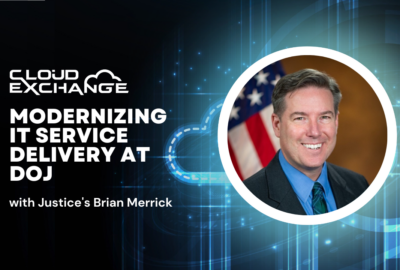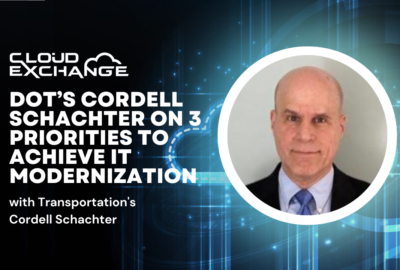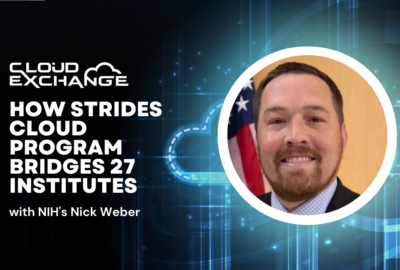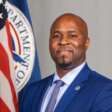

TSA Chief Information Officer Yemi Oshinnaiye says one of his top priorities is improving customer experience across all agency missions.
The Transportation Security Administration is making better customer experience a central part of its broader IT transformation goals.
TSA Chief Information Officer Yemi Oshinnaiye said one of his top priorities is improving customer experience across all agency missions.
“One of the things that keeps me up at night is making sure that we can help secure transportation and make it safe for people to travel. We do a lot of work in being innovative, keeping our systems up to date, making sure that we have a great customer experience,” Oshinnaiye said during the Federal News Network Cloud Exchange 2023.
The agency’s cloud infrastructure is helping the agency make better use of its data, and allowing the agency to keep making iterative improvements to the way it delivers services.
“Customer experience goes beyond IT, but IT is here as an enabler. So we try to look at each area from a customer experience perspective,” Oshinnaiye said.
“How can I help, from the time of you going through the checkpoint to be shorter, and a better experience? How can we help the technology track and get feedback of what we can do better? And also, how can we ascertain what you’re feeling when you’re going through a checkpoint?” he added.
Beyond its public-facing role at airport security checkpoints, TSA oversees a broader portfolio of travel that includes pipelines and railways, and is improving the customer experience across all its missions.
“When we take user-centered design and customer experience, to really drive home that holistic understanding of what it is to automate, what does it do for the user … every time you come back through an airport, or if you’re on rail, or if you’re even on the metro, you have a better experience each time,” Oshinnaiye said.
TSA operates in a hybrid environment of on-premises data assets and cloud environments.
“Even though we have some on-prem environments, we’re looking to connect that back to cloud, so we can take information from on-prem in the cloud, and move it back and forth. It’s almost seamless to the user,” Oshinnaiye said.
TSA is transforming the way it builds and deploys systems, using human-centered designed and incorporating user feedback into the products its releases.
Oshinnaiye said TSA relies on software as a service (SaaS) platforms to support “quick builds” and interactive changes that are key to improved customer experience and citizen development.
“As we pick the right SaaS platforms, we enable users to build their own products, as long as they’re secure and they follow up on the guidelines,” he said.
TSA also relies on infrastructure as a service (IaaS) tools to ensure the agency is getting the right data to the right place, at the right time.
“When we’re building systems, we can build systems on demand. We replicate good systems easier, and then we can experiment, find out what’s the most secure way to build a system. What’s the most secure way to transport data? These cloud vendors, they’ve been doing this for a while, so they have best practices that we leverage. We can share [those] between other agencies, and it gives us a leg up to be able to push forward and stay modernized,” Oshinnaiye said.
TSA is also looking for low-hanging fruit for automation, and sees some opportunities to streamline some back office functions
“We can automate and use a lot of analytics that [we] won’t have our staff in the back office having to crunch numbers in Excel anymore. I think that helps out a lot for us, and allows us to use our brains, for the more tactical and the more complex tasks,” Oshinnaiye said.
TSA is able to automate the scalability of its cloud environment as its volume of data grows.
“Understanding what data to put where, how to access data and the speed that’s necessary, it helps us rearchitect things. So as we’re using cloud, it enables us to be better and faster with data.”
TSA is also building robust security into everything it deploys.
“We’re not putting anything out that we don’t think is more secure. We test incredibly, because we want to make sure that we’ve tested everything that we believe that adversary could. It changes the way we think, and it changes our investment in security, and how we look at things.”
TSA is also working on new ways to deliver mobile technology for frontline transportation security officers.
“As travelers, as just individuals, we’ve begun to move faster, and we expect more,” Oshinnaiye said. “TSOs are working really hard to communicate, to support folks going through that environment, it becomes increasingly necessary for them to be able to communicate in a fashion that’s more mobile.”
Oshinnaiye said TSA is still in the process of building and rapidly prototyping new tools for TSOs
TSA is also looking to train and upskill its workforce to understand the role emerging technology is having on the agency’s ability to improve service delivery.
“When it comes to cloud technology, [we’re] actually bringing the vendor in, because they know their product the best, and holding these meetings and trainings to be able to get us to know as much about us as we can, so that as we’re leveraging the technology, we know where it should be leveraged and how to leverage it the best,” Oshinnaiye said.
TSA is calling on much of its executive team to improve its customer experience.
Oshinnaiye said he provides a supporting role to the agency’s chief innovation officer and chief of delivery to keep rolling out new CX improvements.
“The chief innovation officer really broadly looks across all TSA, and says, ‘How can we innovate? How can we put the fear out of innovation and really the spark of ideas back into people,’” he said. “The chief of delivery executive will make sure they’re looking at all the products we’re putting out. Sometimes we need to consolidate, sometimes we need to separate some products, [they’re] keeping an eye on that trajectory of how software is being built.”
TSA is also in the process of hiring a chief technology officer and a chief data officer, but Oshinnaiye said the agency is leaning toward hiring one executive to handle both roles, and having the position filled by the end of the year.
“There are concepts of a CDO/CTO, because the CTO also has to look at data … so we’re leaning towards doing that and making it a combined position,” he said.
To read or watch other sessions on demand, go to our 2023 Cloud Exchange event page.
Copyright © 2024 Federal News Network. All rights reserved. This website is not intended for users located within the European Economic Area.
Jory Heckman is a reporter at Federal News Network covering U.S. Postal Service, IRS, big data and technology issues.
Follow @jheckmanWFED




Chief Information Officer, Transportation Security Administration

Reporter, Federal News Network

Chief Information Officer, Transportation Security Administration
Yemi Oshinnaiye was appointed as the Chief Information Officer for the Transportation Security Administration in May 2022. He is responsible for Information Technology software delivery and support, innovation, cybersecurity and all facets of IT resourcing that TSA uses to accomplish its mission. His oversight of IT enables TSA to provide world class security for the American traveling public, while ensuring the confidentiality, integrity, and availability of TSA data and resources.
Oshinnaiye approaches IT with a strategic mindset, ensuring development and operations are agile and responsive to mission needs. He combines his leadership skills with a passion for solving problems through state-of-the-art technology. Previously, Oshinnaiye held the role of Deputy Chief Information Officer for United States Citizenship and Immigration Services (USCIS) for three years. As DCIO, he was responsible for resource management and delivery of IT capability for the nation’s immigration benefits systems. Prior to returning to federal service, Oshinnaiye served as the Chief Technology Officer for Dev Technology, an IT services and integration company where he led efforts in IT strategy, innovation, and solutions for federal clients.
Before Oshinnaiye’s tenure as a CTO, he spent more than five years with the USCIS Office of Information Technology, where his team provided leading-edge authentication solutions to validate applicants’ identities. He was also responsible for implementing software projects and leading efforts to transform delivery to lean-agile cloud services. In addition, Oshinnaiye served as Chief of the Enterprise Infrastructure Division, where he extended cloud capabilities and platforms to enable the expansion of a microservices architecture and further integration with cloud services. He expanded automated deployment capabilities and modernized the USCIS Contact Center by integrating a customer relationship management platform with telephony services and distributed immigration systems.
Before joining USCIS, Oshinnaiye was an entrepreneur and provided IT support, software development and internet-based telephony services to local government agencies, non-profits, and health organizations. Oshinnaiye is a proud graduate of Georgetown University.

Reporter, Federal News Network
Jory Heckman has been a reporter at Federal News Network since January 2018. Jory got his start as an intern in 2011 and was a digital news writer and editor for Federal News Network from 2014 to 2018. He also worked as a desk assistant with CBS News Radio in New York and was a reporter for the Citizens’ Voice newspaper in Wilkes-Barre, Pennsylvania.
